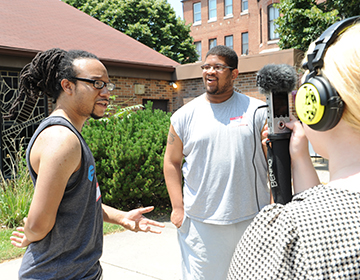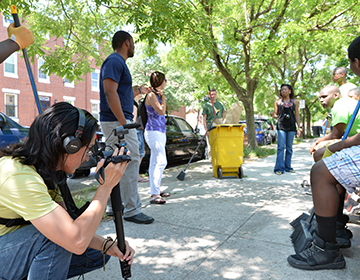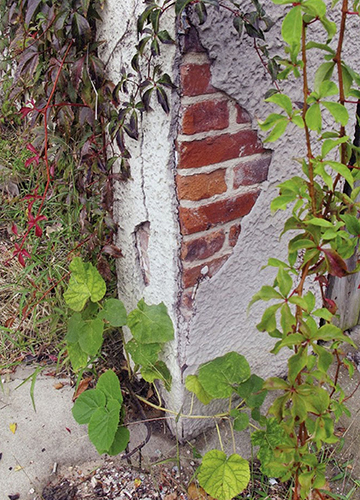Baltimore Rewired
TU researchers get community voices heard

In cities that struggle with negative images, all the talk about what’s going wrong makes it hard to hear what’s going right.
Raul Ceballos ’13 wanted to change that. He found his chance in Towson University’s “Anthropology By the Wire” project, a digital video and research initiative headed by anthropology professors Matthew Durington and Sam Collins.
Named as a nod to HBO’s gritty, violent portrayal of Baltimore, “Anthropology by the Wire” embedded community college students in Baltimore communities struggling against oppression, stigma and economic disadvantage.
Through four summers, the students recorded and shared the communities’ perspectives without the usual filters, spotlighting the first steps toward meaningful solutions. They interviewed people one-on-one, then used editing equipment and a web platform to share their work in those communities and beyond.

“It was really a question of, ‘How can we portray this individual within the larger framework, but keep the story centered in their eyes?’” Ceballos explains.
The student researchers in “Anthropology by the Wire” focused on how development, litter, HIV/AIDS, deindustrialization and unemployment affect marginalized groups in Baltimore. Their videos gave the communities a stronger voice, and gave the students an immersive look at how anthropology and activism work.
“You’re not speaking for. You’re trying to speak with,” says Durington. “You’re not speaking about. You’re trying to speak alongside.”
The community college element of the TU-led community engagement and outreach project was a condition of its National Science Foundation funding. Nearly half of Towson’s current students have transferred from community colleges, so “Anthropology by the Wire’s” work also serves as a conduit that may draw students to Towson. Ceballos transferred from Montgomery College in 2011.
Teamwork in Sharp-Leadenhall
This summer, Ceballos worked in the Sharp-Leadenhall community of Southwest Baltimore, where the likely development of condominiums threatens to price underprivileged residents out of the neighborhood, even while a youth-led initiative to clean up its streets is taking off. The boys, mostly middle-school aged, get up at 6:30 a.m. to pick up litter. The small stipend they receive makes them feel like they have a job, and the work breeds respect in their marginalized community.
“I’m seeing first-hand assumptions that are made about youth of color, and this is a complete contradiction to that,” Ceballos points out. “Some of these kids live in subsidized housing. They live in the very places where people make assumptions that they have no values.”

“A lot of kids want to work,” says Betty Bland-Thomas, a homeowner and community activist working to ensure that the Sharp-Leadenhall neighborhood keeps its historic roots—and its residents—when the condos go up. “The kids take pride in what they’re doing. The skill sets they’re developing now, they can take into their next job.” See the boys at work in the Sharp-Leadenhall Clean and Green video.
Pride and Identity
Ceballos was among the supporters at the Hamilton Arts Collective in Northeast Baltimore during a photography exhibit by JACQUES Initiative volunteers. The HIV/AIDS education and outreach group is comprised largely of those infected with the disease. It has partnered with “Anthropology by the Wire” all four years of the project.

“The reality is we have much more in common than we think we do,” says Bridget Sullivan, a TU art professor and codirector of the collective, explaining why it hosted the exhibit. “But we don’t really have an opportunity to talk about it or understand each other’s thoughts.”
One photo in the exhibit shows the end of a brick wall, surrounded by weeds, coated with layers of flaking and chipped cement and paint. This photo, taken by Kithia Gray, is an image that JACQUES volunteer Evelyn Nicholson identified with most.
“It shows that, even though you have all these layers of things going on with you, you've got to peel them off one at a time to get to the core of who you really are,” she says.
Anthropology Today
That’s exactly what anthropology tries to do, too: chip away at all the layers that cover a community’s true identity. But Durington and Collins developed “Anthropology by the Wire” to do more than encourage conversation and student success. They also wanted to craft a new role for anthropology in the 21st century. They continually find new ways to link the project to their classes, engaging technology and new methods of teaching, observing, relating and sharing experiences. Collins, teaching in South Korea on a Fulbright Scholarship this academic year, will link up with Durington via video chat and connect the two nations’ students so that they can share their perspectives. And they’re working on a smart phone application that will allow anyone who downloads it to gain anthropological perspective on Baltimore.
For Ceballos, the Montgomery County-raised son of Mexican immigrants, Baltimore and the “Anthropology by the Wire” project have been eye-opening, personally as well as academically.
“Living in Baltimore has actually revealed to me that, even as someone of color, I have also internalized some misconceptions,” he says. “It has really given me the opportunity to grow.”